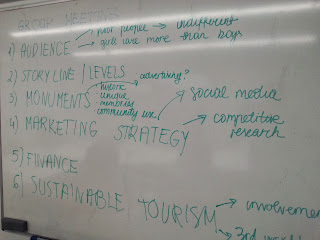While after week 7 presentation we were very satisfied with the reception of our team brand identity, week 8 meeting left us a bit disoriented about which of
the three ideas for the game was the most apt to be developed. We
came to the class confident about our proposals, but something
during the presentation seemed to go wrong. In my opinion, in that occasion our
main mistake was the lack of a part of the presentation specifically aimed to illustrate our approach to the theme
of “world heritage”, which we had been assigned on week 7.
While developing our game ideas, we had obviously confronted
extensively with the many angles of the topic, however, in the context of
the presentation, a introductory conceptualization of the theme
would have probably allowed to illuminate better strengths and
peculiarities of the single ideas. The conversation with Jo and Sara
and the confrontation with other groups' proposals has nevertheless
been extremely useful. In particular we realized the benefits of less
complex game ideas when aiming to spread awareness about a
particular issue.
There
are obviously dangers when committing a moral theme to a simple
game-design, the most important appeared to be didacticism.
While a complex design allows to place instructive messages deeper in
game dynamics, a simpler architecture has to rely on playability and
capacity to generate fun in order to avoid to be perceived as
preachy. In online conversations we subsequently decided to come to
our following meeting both with re-elaborations of the first three
proposals, as well as with some possible new ideas. During that week
I focused mostly on modifying our third idea, a puzzle game focused
on biodiversity, figuring out some graphical possibilities for
the representation of ecosystems, an aspect that Sara pointed out as
potentially problematic. In that process I ended up with shifting the
whole game dynamic from “fix an ecosystem” to “build your own
ecosystem”. In my opinion, that move allowed to overcome the
problems of verisimilitude and scientific precision inherent to the
graphical representation of an ecosystem. Therefore, rather than
teaching about relations among specific life forms and natural
elements, the game would have generically educated players about
interdependence among biological forms and environments. During that
same week I also worked on the fictional world of our second
proposal, a fixed shooter game focused on the theme of cultural
heritage, which seemed the best received during the presentation.
At
the following meeting, Ruta came with a very nice and simple idea
focused on cultural heritage and sustainable tourism,
whose working title was “the owl prowl”. In her idea the main
character was a owl, in Greek mythology the sacred bird of Athena,
protectress of the arts. Referring to tourism flow to Machu Picchu,
she gave us an example of possible game dynamics explaining that the
owl might have been a defender of cultural sites from unsustainable
tourism practices. During the meeting we realized the potentialities
of this proposal, especially in the perspective of limiting the topic
to a particular aspect, as suggested by Jo and Sara. At the same time
emerged as relevant the risk of didacticism previously pointed out,
and the importance assumed by an effective design of the different
game levels. In that context, in order to increase humor, I proposed
to abandon the mythological vibe of the original idea, and focus
instead on a more controversial “flying hero” such as a pigeon,
a common inhabitant of cultural monuments, ascribable of more
“personal” and less didactic reasons to protect monuments.
For
the following group meeting I worked on this new storyline, and after
debating with the group we presented this new idea to Sara and Jack
on the 3 of December.
Pigeons
notoriously populate monuments
across Europe, being often perceived as a bother, a sanitary problem
and a threat to architectural beauties. Our idea for the storyline is
to re-imagine this unavoidable presence as an army of protectors of
cultural sites, a special
force disseminated
worldwide. The fact that pigeons are also known for being travellers
can constitute a narrative device to bring our protagonist/s in
places where they are not expected to live. At the moment of writing,
indeed, our idea is to dedicate each level to a different cultural
site across the world, developing the game dynamics in the direction
of a pigeon contrasting specific unsustainable tourism practices.
The
ironical twist
implicit in
the conversion of pigeons to heroes, and propagators of awareness
constitutes the aesthetic code we aim to give to the game, and it
would be developed in various directions. Still we have to decide if
constructing our game around a single heroic pigeon, a squad of few
characterized heroes, or instead a wider team mostly characterized
collectively. However, our intent is to sketch out our character/s as
very proud,
and completely engaged in a mission whose value is regularly
misunderstood by those who should appreciate it most, i.e. humans. In
the context of our game, focused on sustainable tourism, this theme
of the misunderstood
hero
has obvious resonances in the fact that humans represent one main
threat to cultural and natural heritage. This double
relation between humans and heroic pigeons
could be explicitly articulated in the game dynamics of some of the
levels, where beside the activity of contrasting and preventing bad
tourism practices, pigeons might have to face obstacles and direct
threats
brought by humans, e.g. traps
and various devices to keep birds away from monuments. More in
general, we are conceiving various disturbing factors to the pigeons'
mission, apart from the mission's difficulty, in order to enrich game
dynamics. Here's a provisional list:
- Traps placed by humans;
- Difficult flight-zones (pigeons flight is very skilled, but they walk very slow);
- Watchmen;
- Hyperactive kids;
- ...
On
the other side, pigeons can rely on some helping factors, and to
peculiar abilities:
- Old Lady’s Boosting Crumbs: awarded troops tend to have a privileged relation with old ladies attending public parks (increased speed/height-ability of flight);
- Pigeons Droppings: flying forces make use of controversial, non-conventional weapons to dissuade spiteful tourists.
- The Power of Love: in moments of difficulty, pigeons might be able to call for immediate help from a partner by simply cooing.
- ...
A
further development of the ironical vibe implicit in the assumption
of pigeons to heroes might take place in the pauses between one level
and the following, where brief
animations
could show humans complaining about pigeons, cleaning the dirt they
leave (“their heritage”), or shooing them out of historical
buildings.
At
the moment we are developing the game in the direction of a hero, or
many heroes, facing unsustainable tourist practices in various
geographical settings, chosen for their appeal and fame and for the
particular problems tourism generates to local communities, to the
monuments themselves, or to the natural environment. Quite obviously,
these relations with places of tourist interest might represent an
opportunity for the financing of the game, as well as for its
advertising. A detailed presentation of these possibilities and of the
game-design of the single levels will soon be given in future posts by me
and the other members of the group.
Michele Bruzzi






